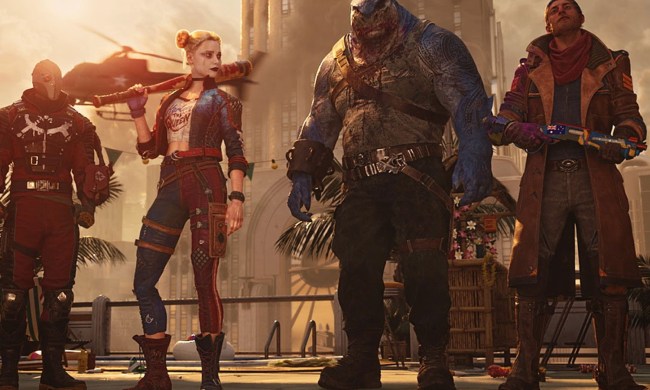The world of Dungeons & Dragons, which is of course where Baldur’s Gate 3 comes from, is all about choice and crafting your own story through the world. Baldur’s Gate 3 promises plenty of ways to alter the story, including a reported 1,700 different ending permutations. But the first and most important decision you make will be which class your main character is. Along with your race, your class is what will define how your character plays, including what roles they are best suited for and what abilities they can learn in and out of combat. With 12 to pick from at the start, plus 48 total subclasses within those main 12, it can feel like an overwhelming choice to make so early. To make things easier, we’ll break down all the classes in Baldur’s Gate 3 to help you decide which one to pick.
All Baldur’s Gate 3 classes
Barbarian
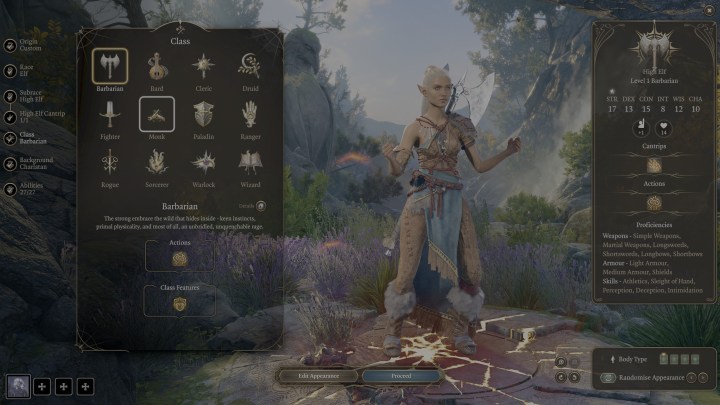
The Barbarian is likely the easiest class to wrap your head around just based on the name. This class focuses primarily on the Strength stat and is all about melee damage. They are proficient with light and medium armor, shields, simple and martial weapons, plus get the unique Rage class action. When you enter the Rage state, you deal more damage and can survive fatal wounds. Their saving throws are linked to the Strength and Constitution stats.
The Barbarian subclasses are Berserker, Wildheart, and Wild Magic.
Bard
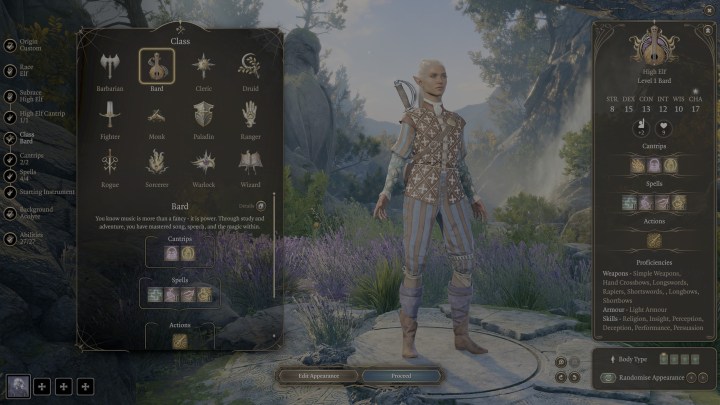
Bards are probably not going to be a popular pick for most players, but don’t judge them too quickly! Yes, the Bard focuses on music to buff their companions as opposed to being the frontline fighter or casting flashy spells, but they will keep your party alive and are one of the best choices for skill checks outside of combat thanks to their high charisma. Bards are proficient in light armor, simple weapons, hand crossbows, longsword, rapier, shortsword, and musical instruments (of course). Your class action is Bardic Inspiration which buffs an ally’s next attack, ability check, or saving throw. Speaking of, your saving throw will be related to your dexterity and charisma.
The Bard’s subclasses are College of Lore, College of Valor, and College of Swords.
Cleric

Now we’re getting to the more magical classes. Clerics use the power of their gods to fuel their magic, which also influences how you interact with characters in the world depending on which faith you choose to follow. You will have a range of all types of spells, including offensive, defensive, and healing. Clerics use light or medium armor, shields, and simple weapons. What is unique about Clerics is that they can also go right into any of their subclasses as soon as you start.
The Cleric subclasses are Life Domain, Light Domain, Trickery Domain, Knowledge Domain, Nature Domain, Tempest Domain, and War Domain.
Druid
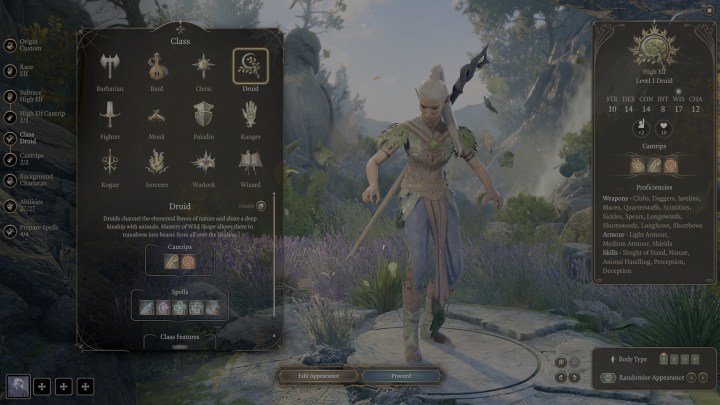
If that Druid clip the devs showed us got you interested in this class, why not give it a spin for yourself? This is another spellcasting class, but obviously, nature and shapeshifting-focused. They can use most weapon types in the game, but their real power is the Wild Shape ability that lets them transform into a specific creature that has its own HP pool and abilities, effectively allowing you to play two roles in one. Intelligence and wisdom will be your main stats for this class.
The Druid subclasses are Circle of the Land, Circle of the Moon, and Circle of Spores.
Fighter
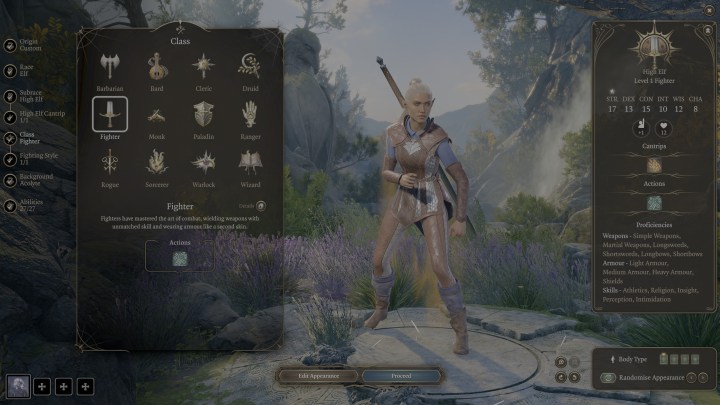
The classic Fighter is probably the best choice for newcomers because of its straightforward nature. You can pick between strength or dexterity-focused builds if you want to use melee or ranged/finesse weapons, can use any type of armor, and most weapons. This class also gets access to the Second Wind ability to use a bonus action to regain HP based on your level. Saving throws will be tied to strength and constitution.
The Fighter subclasses are Battle Master, Eldritch Knight, and Champion.
Monk

This isn’t your peaceful, pacifist-style Monk, but your quiet and deadly type. This class is perfect if you want to go with a fully hand-to-hand based character that is fast and deadly. You will mainly be pumping dexterity, but also wisdom to fuel your Ki attacks. You won’t be wearing much of any armor with this class, so make sure you don’t get hit. Your saving throws are based on strength and dexterity.
The Monk subclasses are Way of the Open Hand, Way of the Shadow, and Way of the Four Elements.
Paladin
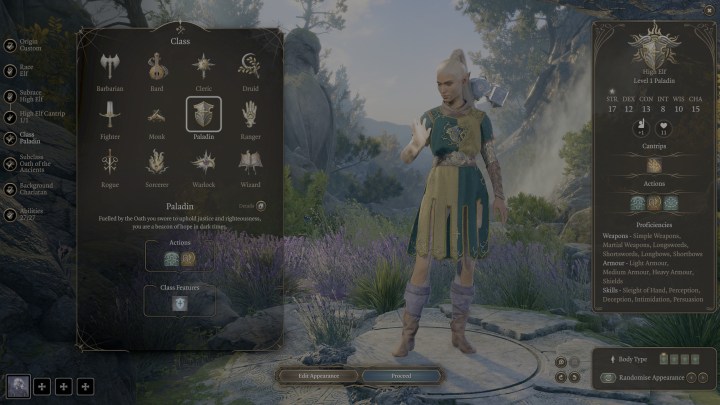
You could think of the Paladin as the more melee-focused version of the Cleric since they both draw power from faith. That said, the Paladin still does have some powerful spells for healing and buffs to back up their brawn in battle. All armor is available here, with simple or martial weapons being preferred. Paladins also come with the Lay on Hands class action which is a simple healing move you can use on any target (including themselves) you touch for 4 HP. Also like the Cleric, you will choose your subclass right away.
The Paladin subclasses are Oath of the Ancients, Oath of Devotion, Oath of Vengence, and Oathbreaker (unlocked by breaking any of the other oaths).
Ranger
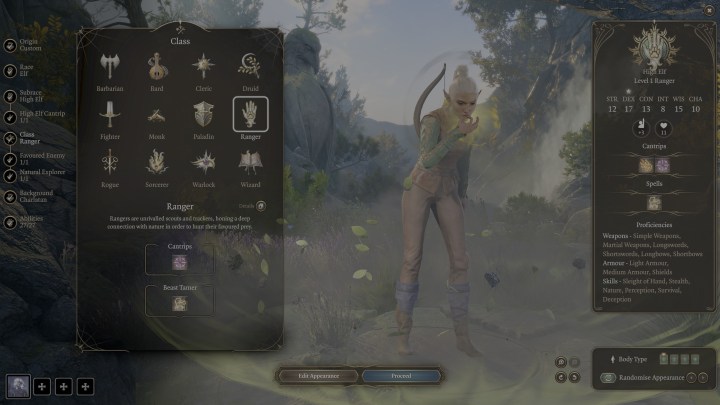
If you fancy yourself a more subtle, hunter-like player, go for the Ranger. While you will mainly be using ranged weapons, Rangers also have a nice set of spells and passive abilities to make hunting and ambushing targets quite effective. Dexterity will obviously be your primary stat here, with strength also contributing to your saving throws. Rangers can also get access to an animal companion to help them in battle.
The Ranger subclasses are Hunger, Beast Master, and Gloom Stalker.
Rogue
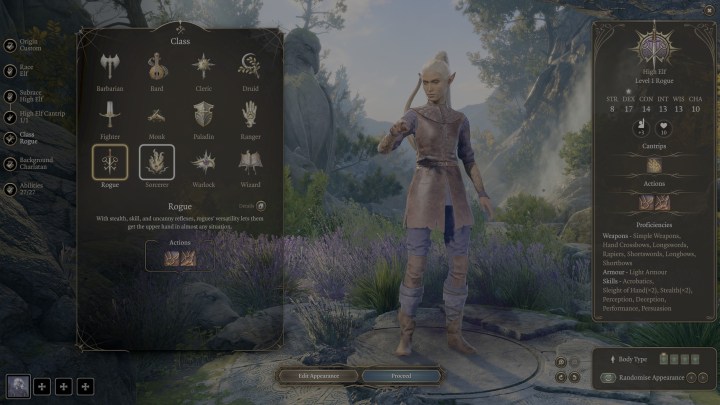
Want to stick to the shadows, strike, and slink away unnoticed? If so, pick a Rogue. This class is all about dealing critical strikes to unaware enemies from hidden locations with close or long-range weapons. For this, dexterity will be your main stat to focus on, with some intelligence to help your saving throws. Outside of combat, this class can also help you get around by sneaking through enemy encampments, picking locks, and disarming traps.
The Rogue subclasses are Arcane Trickster, Thief, and Assassin.
Sorcerer
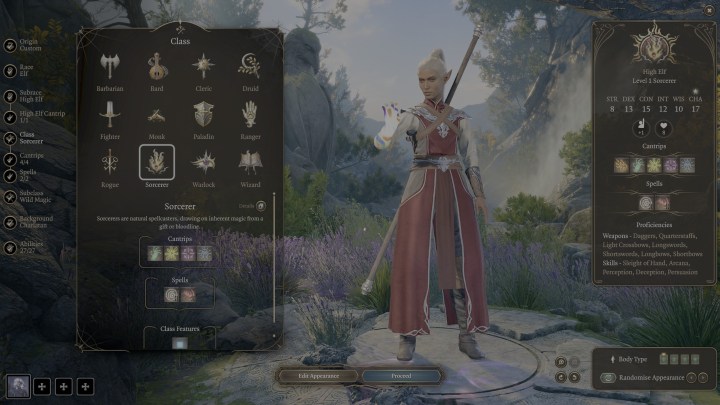
Sorcerers may be spellcasters, but they focus on charisma to power their magic. Obviously, you will primarily be using spells, but the type and their effect will all depend on your subclass and origin, which you will choose right away. Saving throws are linked to constitution and charisma again, and while you could use a dagger or light crossbow, quarterstaffs are your best weapons.
The Sorcerer subclasses are Wild Magic, Draconic Bloodline, and Storm Sorcery.
Warlock
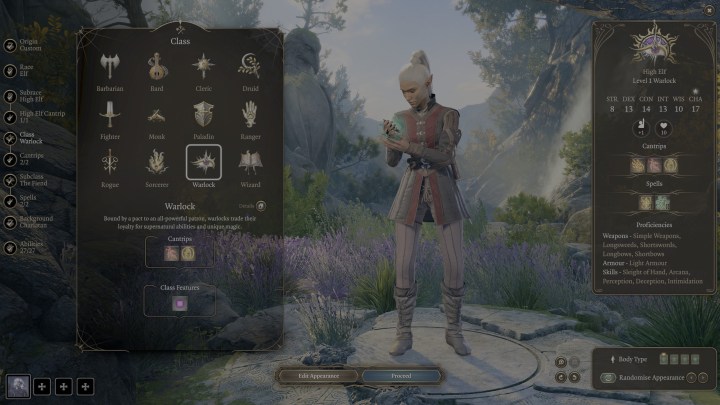
Unlock Sorcerers, Warlocks get their magic from a deal struck with an Otherworldy Patron of the Realms, which can vary depending on which subclass you choose. They can also utilize some light armor and simple weapons, but to balance out how strong their spells can be, have fewer slots than other magic classes. Charisma will be your main stat here as well, plus wisdom for saving throws.
The Warlock subclasses are The Fiend, The Great Old One, and The Archfey.
Wizard

Last up, yet another magic user is the Wizard. This is the image you most likely have in your mind for a magic user, who is focused on intelligence and wisdom, staffs, and can learn a wide range of spells. Because of how many subclasses there are that completely change your spell options, the Wizard is perhaps the most versatile class in the game. To help your casting, Wizards get the Arcane Recovery class action that, once per day and while out of combat, allows you to replenish your spell slots.
The Wizard subclasses are Evocation, Abjuration, Conjuration, Divination, Enchantment, Necromancy, Illusion, and Transmutation.



